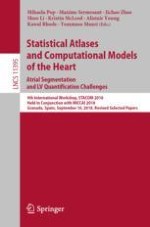2019 | OriginalPaper | Chapter
Automatically Segmenting the Left Atrium from Cardiac Images Using Successive 3D U-Nets and a Contour Loss
Authors : Shuman Jia, Antoine Despinasse, Zihao Wang, Hervé Delingette, Xavier Pennec, Pierre Jaïs, Hubert Cochet, Maxime Sermesant
Published in: Statistical Atlases and Computational Models of the Heart. Atrial Segmentation and LV Quantification Challenges
Publisher: Springer International Publishing
Activate our intelligent search to find suitable subject content or patents.
Select sections of text to find matching patents with Artificial Intelligence. powered by
Select sections of text to find additional relevant content using AI-assisted search. powered by
